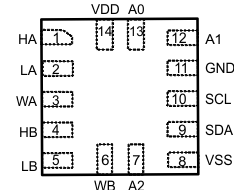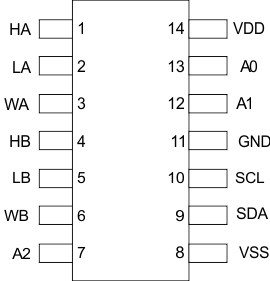SLIS134C March 2011 – September 2015
PRODUCTION DATA.
- 1 Features
- 2 Applications
- 3 Description
- 4 Revision History
- 5 Pin Configuration and Functions
- 6 Specifications
-
7 Detailed Description
- 7.1 Overview
- 7.2 Functional Block Diagram
- 7.3 Feature Description
- 7.4 Device Functional Modes
- 7.5 Programming with I2C
- 7.6
Register Maps
- 7.6.1 Slave Address
- 7.6.2 TPL0102 Register Map
- 7.6.3 IVRA (Initial Value Register for Potentiometer A)
- 7.6.4 WRA (Wiper Resistance Register for Potentiometer A)
- 7.6.5 IVRB (Initial Value Register for Potentiometer B)
- 7.6.6 WRB (Wiper Resistance Register for Potentiometer B)
- 7.6.7 ACR (Access Control Register)
- 8 Application and Implementation
- 9 Power Supply Recommendations
- 10Layout
- 11Device and Documentation Support
- 12Mechanical, Packaging, and Orderable Information
Package Options
Mechanical Data (Package|Pins)
Thermal pad, mechanical data (Package|Pins)
- PW|14
Orderable Information
5 Pin Configuration and Functions
RUC Package
14-Pin MicroQFN
Top View

PW Package
14-Pin TSSOP
Top View

Pin Functions
| PIN | I/O | DESCRIPTION | |
|---|---|---|---|
| NAME | NO. | ||
| HA | 1 | I/O | High terminal of potentiometer A |
| LA | 2 | I/O | Low terminal of potentiometer A |
| WA | 3 | I/O | Wiper terminal of potentiometer A |
| HB | 4 | I/O | High terminal of potentiometer B |
| LB | 5 | I/O | Low terminal of potentiometer B |
| WB | 6 | I/O | Wiper terminal of potentiometer B |
| A2 | 7 | I | I2C address bit 2 |
| VSS | 8 | – | Negative power supply pin (Dual-Supply Operation) or tied to GND (Single-Supply Operation) |
| SDA | 9 | I/O | I2C data I/O |
| SCL | 10 | I | I2C clock Input |
| GND | 11 | – | Ground |
| A1 | 12 | I | I2C address bit 1 |
| A0 | 13 | I | I2C address bit 0 |
| VDD | 14 | – | Positive power supply pin |